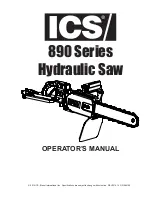
www.scheppach.com /
+(49)-08223-4002-99 /
+(49)-08223-4002-58
GB
| 29
•
Insure that the workpiece does not roll when cut
-
ting round pieces.
•
For safe work when transverse cutting, use the
special transverse cutting gauge accessory.
10.1 Performing longitudinal cuts (Fig. A)
Here, a workpiece is cut in its longitudinal direction.
•
Position the longitudinal fence (5) on the left side
(if possible) of the saw band, in accordance with
the desired width.
•
Lower the saw band guide (4) onto the workpiece.
•
Switch on the saw.
•
Press one edge of the workpiece against the lon
-
gitudinal fence (5) with the right hand, whilst the
flat side lies on the saw bench (6).
•
Slide the workpiece at an even feed rate along the
longitudinal fence (5) into the saw band.
•
Important: Long workpieces must be secured
against tipping at the end of the cutting process
(e.g. with reel-off stand, etc.)
•
Attention! When processing narrower workpieces
it is essential to use a push stick.
The push stick (N) must always be stored within
reach, on the hook (i) provided for this purpose on
the side of the saw (Fig. 15).
10.2 Angled cuts (Fig. B+ Fig. 6)
•
In order to execute angled cuts parallel to the saw
band, it is possible to tilt the saw bench (6) for
-
wards from 0° - 45°.
•
Release the locking handle (E).
•
Tilt saw bench (6) forwards, until the desired angle
is set on the degree scale.
•
Retighten the locking handle (E).
•
Attention: With a tilted saw bench (6), the longitudi
-
nal fence (5) must be positioned on the downward
facing side to the right of the saw band in the work
-
ing direction (if the workpiece width allows this),
in order to secure the workpiece against slipping.
•
Perform the cut as described under 10.1.
10.3 Freehand cuts (Fig. C)
One of the most important features of a band saw is
the ease with which it can cut curves and radii.
•
Lower the saw band guide (4) onto the workpiece.
•
Switch on the saw.
•
Press the workpiece firmly onto the saw bench (6)
and slowly slide into the saw band.
•
During freehand cutting you should always work
with a low advancing speed, so that the saw band
can follow the desired line.
•
In many cases it is helpful to roughly saw curves
and corners approximately 6 mm from the line.
•
If it is necessary to saw curves that are too tight
for the saw band used, auxiliary cuts must be sawn
up to the front face of the curve, so that these fall
off as wood waste when the final radius is sawn.
9. Transport
The machine must only be lifted and transported on
its frame or the frame plate. Never lift the machine at
the safety devices, the adjusting levers, or the saw
-
ing table.
During the transport the saw blade protection must
be in the lowest position and near the table.
Never raise at the table!
Unplug the machine from the mains during transport.
10. Working instructions
The following recommendations are examples of the
safe use of band saws. The following safe working
methods should be seen as an aid to safety. They
cannot be applied suitably completely or comprehen
-
sively to every use. They cannot treat every possible
dangerous condition and must be interpreted care-
fully.
•
Connect the machine to a suction unit when work
-
ing in closed rooms. A suction device which con
-
forms with commercial regulations must be used
for suction in commercial areas.
•
Loosen the sawband when the machine is not in
operation (e.g. after finishing work). Attach a no
-
tice on the tension of the saw band to the machine
for the next user.
•
Collect unused sawbands and store them safely in
a dry place. Check for faults (teeth, cracks) before
use. Do not use faulty sawbands!
•
Wear suitable gloves when handling sawbands.
•
All protective and safety devices must be securely
mounted on the machine before beginning work.
•
Never clean the sawband or the sawband guide
with a hand-held brush or scraper while the saw
-
band is running. Resin-covered sawbands impair
working safety and must be cleaned regularly.
•
For your own protection, wear protective glasses
and hearing protection. Wear a hairnet if you have
long hair. Roll up loose sleeves over the elbows.
•
Always position the sawband guide as near the
workpiece as possible when working.
•
Insure sufficient lighting in the work area and
around the machine.
•
Always use the fence for straight cuts to keep the
workpiece from tipping or slipping away.
•
When working on narrow workpieces with manual
feed, use the push stick.
•
For diagonal cuts, place the saw bench in the ap
-
propriate position and guide the workpiece on the
fence.
•
Insure safe workpiece guidance.
•
For arced and irregular cuts, push the workpiece
evenly using both hands with the fingers togeth
-
er. Hold the workpiece with your hands on a safe
area.
•
Use a pattern for repeated arced or irregular cuts.
Содержание 4901501901
Страница 6: ...www scheppach com service scheppach com 49 08223 4002 99 49 08223 4002 58 6 B C D A...
Страница 20: ...www scheppach com service scheppach com 49 08223 4002 99 49 08223 4002 58 20 DE...
Страница 191: ...www scheppach com service scheppach com 49 08223 4002 99 49 08223 4002 58 191...
Страница 192: ...www scheppach com service scheppach com 49 08223 4002 99 49 08223 4002 58 192 R1 R2 K2 K2 K1 230V C...
Страница 193: ...www scheppach com service scheppach com 49 08223 4002 99 49 08223 4002 58 193...
















































